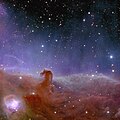Plaetje:Euclid’s view of the Horsehead Nebula ESA25170866.jpg

Oearsprunkelik bestandj ((8.200 × 8.200 pixel, besjtandsgruutde: 1,84 MB, MIME type: image/jpeg))
Dit besjtandj kump van Wikimedia Commons en kin ouch in anger projekte gebroek waere. De pagina mit de besjtandjsbesjrieving wurt hiejónger weergegaeve.
Besjrieving
| BesjrievingEuclid’s view of the Horsehead Nebula ESA25170866.jpg |
English: Euclid shows us a spectacularly panoramic and detailed view of the Horsehead Nebula, also known as Barnard 33 and part of the constellation Orion.
At approximately 1375 light-years away, the Horsehead—visible as a dark cloud shaped like a horse’s head—is the closest giant star-forming region to Earth. It sits just to the south of star Alnitak, the easternmost of Orion’s famous three-star belt, and is part of the vast Orion molecular cloud. [Image description: This square astronomical image is divided horizontally by a waving line between a white-orange cloudscape forming a nebula along the bottom portion and a comparatively blue-purple-pink upper portion. From the nebula in the bottom half of the image, an orange cloud shaped like a horsehead sticks out. In the bottom left of the image, a white round glow is visible. The clouds from the bottom half of the image shine purple/blue light into the upper half. The top of the image shows the black expanse of space. Speckled across both portions is a starfield, showing stars of varying sizes and colours. Blue stars are younger and red stars are older.] Tiếng Việt: Tinh vân Đầu Ngựa, còn được gọi là Barnard 33 và là một phần của chòm sao Orion |
| Datum | 7 november 2023 (uploaddatum) |
| Brón | Euclid’s view of the Horsehead Nebula |
| Sjriever | ESA/Euclid/Euclid Consortium/NASA image processing by J.-C. Cuillandre (CEA Paris-Saclay) G. Anselmi |
| Anger versies |
|
| Activity InfoField | Space Science |
| Keyword InfoField | Horsehead Nebula Stars |
| Mission InfoField | Euclid |
| Set InfoField | Euclid First Images |
|

|
This image was selected as picture of the day on Vietnamese Wikipedia.
|
Licentie:
This media was created by the European Space Agency (ESA).
Where expressly so stated, images or videos are covered by the Creative Commons Attribution-ShareAlike 3.0 IGO (CC BY-SA 3.0 IGO) licence, ESA being an Intergovernmental Organisation (IGO), as defined by the CC BY-SA 3.0 IGO licence. The user is allowed under the terms and conditions of the CC BY-SA 3.0 IGO license to Reproduce, Distribute and Publicly Perform the ESA images and videos released under CC BY-SA 3.0 IGO licence and the Adaptations thereof, without further explicit permission being necessary, for as long as the user complies with the conditions and restrictions set forth in the CC BY-SA 3.0 IGO licence, these including that:
See the ESA Creative Commons copyright notice for complete information, and this article for additional details.
|
 | |
Dit bestand is gelicenseerd onder de Creative Commons Naamsvermelding-GelijkDelen 3.0 IGO licentie. Attribuusje: ESA/Euclid/Euclid Consortium/NASA, image processing by J.-C. Cuillandre (CEA Paris-Saclay), G. Anselmi, CC BY-SA IGO 3.0
| ||
Dit bestand, dat oorspronkelijk toegevoegd was op Euclid’s view of the Horsehead Nebula, werd op 13 november 2023 beoordeeld door de moderator of reviewer Юрий Д.К., die bevestigt dat dit bestand beschikbaar was onder de vermelde licentie op die datum.
|
Bijschriften
Items getoond in dit bestand
beeldt af Nederlands
Paardenkopnevel Nederlands
auteursrechtenstatus Nederlands
auteursrechtelijk beschermd Nederlands
licentie Nederlands
MIME-type Nederlands
image/jpeg
hoogte Nederlands
8.200 pixel
breedte Nederlands
8.200 pixel
datagrootte Nederlands
1.925.643 byte
checksum Nederlands
c128318f38ea88c7da0a62dc209a407e6cf41e26
datum van oprichting of creatie Nederlands
7 nov 2023
bron van bestand Nederlands
bestand beschikbaar op internet Nederlands
pHash-checksum Nederlands
5qju5gik7a1tmf81iz4c7n0btv09ef7iz94girulklo143cu3c
kwaliteitsbeoordeling op Commons Nederlands
uitgelichte afbeelding op Wikimedia Commons Nederlands
Besjtandshistorie
Klik op 'ne datum/tied óm 't besjtand te zeen wie 't oetzaog op det tiedsjtip.
| Datum/Tied | Miniatuurplaetje | Aafmaetinge | Gebroeker | Kómmentaar | |
|---|---|---|---|---|---|
| hujig | 7 nov 2023 20:50 |  | 8.200 × 8.200 (1,84 MB) | OptimusPrimeBot | #Spacemedia - Upload of https://www.esa.int/var/esa/storage/images/esa_multimedia/images/2023/11/euclid_s_view_of_the_horsehead_nebula/25170855-1-eng-GB/Euclid_s_view_of_the_Horsehead_Nebula.jpg via Commons:Spacemedia |
Plaetjesverwiezinge
Gein inkel pazjena gebroek dit plaetje.
Globaal besjtandjsgebroek
De volgende anger wiki's gebroeke dit bestandj:
- Gebroek in fr.wikipedia.org
- Gebroek in he.wikipedia.org
- Gebroek in ru.wikipedia.org
- Gebroek in vi.wikipedia.org
Metadata
Dit besjtand bevat extra gegaeves, waorsjienlik door de digitale camera of scanner biegevoog. Es 't oersjprunkelik besjtand aangepas is, kin 't zeen dat sómmige details neet mie bie 't gewiezigde plaetje hure.
| Pixelcompositie | RGB |
|---|---|
| Omsjrieving aafbeilding |
|
| Oriëntatie | Normaal |
| Horizontaal resolutie | 1 dpi |
| Verticaal resolutie | 1 dpi |
| Gebroekdje software | GIMP 2.10.18 |
| Datum en momènt besjtandjsverangering | 29 okt 2023 09:54 |
| Datum en memènt van óntstoon | 29 okt 2023 00:00 |
| Unieke ID van 't origineel dokement | xmp.did:93eb5251-7bdb-4a71-84ac-e2d7aedbd77e |
| IIM-versie | 2 |



